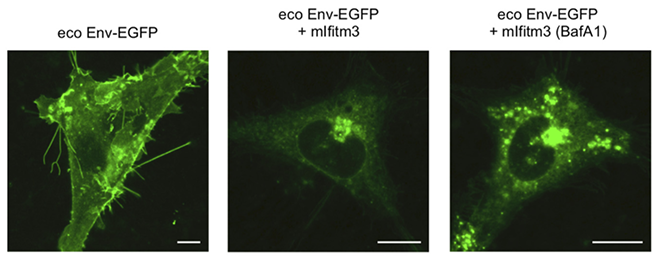Sharing a lab with another team may sound like an inconvenience to some, like the professional equivalent of sharing a bedroom with a sibling.
But not for Alex Compton, Ph.D.; Alan Rein, Ph.D.; and their colleagues. In their case, sharing a lab led to a rich collaboration, mentoring opportunities, and a study that uncovered facets of how cells interact with viruses.
The partnership began nearly three years ago, when Compton joined the HIV Dynamics and Replication Program at NCI at Frederick as head of the Antiviral Immunity and Resistance Section. His small team was given space in a laboratory partially occupied by Rein’s team, the Retrovirus Assembly Section. Soon, the scientists were sharing ideas and asking questions that required their combined expertise to answer.
“[My team and I] were working on aspects of IFITM function and basic questions. [Alan] simply asked whether they could inhibit [murine leukemia virus], as that happens to be his favorite virus model,” Compton said.
While simple, the question had far-reaching implications for scientists’ understanding of how viruses infect cells and spread in a host. IFITM (interferon-induced transmembrane) is a group of proteins that hinder viral infections in human and animal cells, a sort of cellular immune system. Murine leukemia virus (MLV) is a retrovirus, like HIV and human T-cell lymphotropic virus, that causes leukemia in mice by establishing long-term infections that dodge the mice’s natural defenses.
Compton and his team had previously shown that one protein, IFITM3, could inhibit HIV, and they suspected that it also would inhibit MLV. Joined by Rein and two members of his team, they conducted a study to investigate.
They found that IFITM3 could inhibit MLV—but more importantly, they also figured out how. MLV infects host cells, hijacks them, and turns them into “factories” that make more virus particles to infect other cells. But when MLV infects a cell containing IFITM3, the protein diminishes the produced virus’ ability to infect. Specifically, IFITM3 affects the virus’ spike proteins—the “anchors” by which it grabs hold of uninfected cells—by decreasing both their quantity and quality. Without effective spikes, the virus can’t attach to and enter new cells.
“It’s like removing one of the landing gears from an airplane and then inhibiting the full extension of the landing gear for the ones that happen to be present on the airplane. We actually think it’s doing this in order to dually inhibit the ability for the virus to fuse with cells,” Compton said.
In what Compton calls “a total accident,” the team also revealed that a protein in MLV, called glycoGag, allows the virus to escape from IFITM3’s effects. He says their initial tests showing IFITM3’s strong defense didn’t use a natural strain of MLV. Rather, they used a mutant that lacked glycoGag.
“We realized that we weren’t actually looking at the real virus, so we were looking at a stripped-down version,” Compton said, adding that the team quickly switched to the natural strain and discovered glycoGag’s effects.
The findings expand scientists’ knowledge of viral replication and may be relevant to human virus research, including HIV and human T-cell lymphotropic virus studies. The team hopes to determine whether other viruses have functions that allow them to avoid IFITM3.
“This is an example of a truly basic observation that yields something that can be targeted therapeutically … a viral protein that has the capacity to dismantle some aspect of immunity,” Compton said.
When the Environment Fuels the Science
Yadvinder Ahi, Ph.D., the study’s co-lead author and a former postdoctoral fellow in Rein’s lab (he has since completed his fellowship), believes the study and shared lab are a prime example of what scientific partnerships can do.
“Since this study was highly collaborative, it also showed me that collaboration with other experts in the field can greatly accelerate research. The environment in the workplace was highly conducive for research,” he said.
Compton agrees, pointing out that the close collaboration and sharing of ideas helped the teams to adjust after they discovered they had been using a mutant form of MLV.
“The fact that we have different ways of thinking about things and different experiences enabled us to realize what we had and what we then should do,” he said.
For Ahi, the study also meant a chance to work with and mentor a capable young scientist, Diborah Yimer, the study’s other co-lead author and a former postbaccalaureate fellow in Rein’s lab who is currently attending medical school. (The Poster staff contacted Yimer but was unable to reach her for comment.)
“It was personally satisfying to see someone trained by me develop as a scientist and significantly contribute towards a research paper,” Ahi said.
According to Compton, the duo “did 95% of the work” on the study, either working on experiments side by side or trading them back and forth for the more than two years it took to finish the project. He says their effort—and the successful study—represent the best parts of science: teamwork, egalitarianism, and hard work. Ahi has a similarly positive perspective.
“I find myself fortunate to have worked with the members of the Rein and Compton labs involved in the study. It was a wonderful and great learning experience which allowed me to improve as a scientist,” he said.


